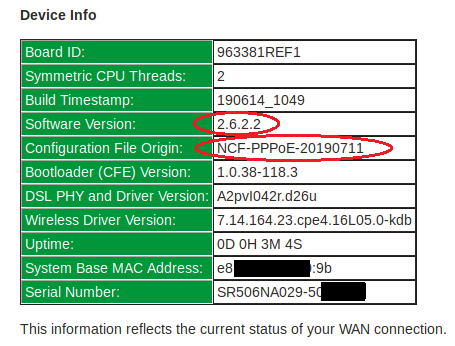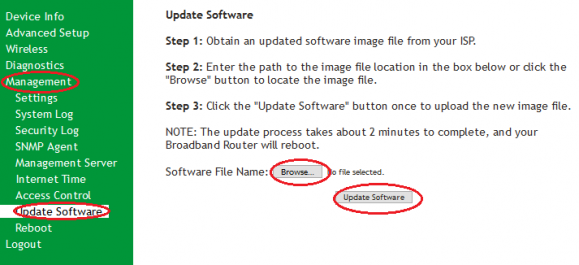SmartRG SR506n
Sold from Aug 2018 to July 2021
- Home
- Configuration from File
- Routed Configuration
- Bridge Configuration
- Firmware Check and Update
- Changing WiFi Channels on SmartRG modems
- Changing WiFi Name or Password on SmartRG modems
- Changing DNS Settings on SmartRG Modems
- Port Forwarding
- About your SmartRG SR506n
- SmartRG - Manual
- SmartRG - Data Sheet
- Highspeed Tips - SR505n Emulator (differs slightly)
Preparation
Updated: 2018-08-20 Recommended Firmware Version: 2.5.0.14
The SmartRG SR506n modem router supports both ADSL mode and VDSL mode. Provided it is configured correctly, it can be switched between ADSL and VDSL plans without the owner having to buy a new modem or even reconfigure your existing one.
- Note: Fees for changing plans may still apply. Consult: DSL Rates
Before you start configuring the SmartRG SR506n, there are 4 things to check:
- Firmware Check: Check if you're using older firmware and upgrade to the recommended firmware version. If you're unable to access the internet to request newer firmware, note that the screenshots shown and steps outlined may not align with what you see. Contact the support@ncf.ca for assistance if you run into problems.
- Factory Settings and Standard Configuration: These instructions assume you're configuring SmartRG SR506n modem out of the box or after a factory reset. If the modem is not new, it is recommended to reset the modem to the factory defaults by holding down the reset button with a paper clip for ~10 seconds.
- Also, these settings are our recommendations for most NCF members. To learn more about making custom changes to your particular modem, consult the manual.
- Modem Installation - Configure over Ethernet: Consult the SmartRG SR506N modem instruction sheet (page 1) on how to set up the modem and connect to it over ethernet. We do not recommend configuring your modem over a WiFi connection.
- Configurations Methods: The 2 main ways of configuring the SmartRG SR506n modem:
- Using a custom configuration File: You can request a custom configuration file for your NCF DSL connection from support@ncf.ca.
- Manually following configuration steps
- Configuration Options:
- Routed Operation with WiFi - Standard configuration for most members with SmartRG SR506n serving as both modem and WiFi router.
- Routed Operation with separate WiFi Router - Recommended configuration for members with their own WiFi router. The modem will make the PPPoE authentication and both devices will negotiate DHCP.
- Bridged Operation with separate WiFi Router - (Advanced) for members with their own routers and are knowledgeable about managing it themselves. The router with handle both authentication and DHCP.
Using Custom Configuration File
Your SmartRG modem can be configured for Routed or Bridged Operation by a custom configuration file. The custom configuration will include parameters specific to your NCF account.
1. Request a custom configuration file from support@ncf.ca and save it at a location you will remember.
Log into Modem Web Interface
2. Enter http://192.168.1.1 info the address bar at in your web browser. Click on Manage Gateway (advanced) and login with username: admin and password: admin (if your modem has been properly reset. If not try your NCF DSL password).
Uploading the File
3. Go to the Management Menu link, and then click on the Settings sub-menu link and then on the Update.
- Click on the Browse link (in the Update Running Broadband Router Settings section) and navigate to the custom configuration file you saved.
- Click on Update Running Settings.
4. Once the file upload begins, it can take 2 to 5 minutes to be completed and for your modem to be fully connected online. Resist the urge to make changes to the modem's configuration during this time.
Routed Operation with WiFi
NCF Support is available to make configuring your SmartRG modem easier and to help you avoid potential mistakes. Here are simpler configuration options for your SmartRG modem:
- You can request a custom configuration file for your NCF DSL connection from support@ncf.ca.
- You may need an alternate means of accessing the internet to download the configuration file.
- Call 613-721-1773 x0 to book a Modem Appointment.
Checklist
| Steps | Menu Navigation | Parameters | |
|---|---|---|---|
| 2 | Log into Modem | http://192.168.1.1
→ Manage Gateway (Advanced) |
User Name: admin
Password: admin |
| 3 | WAN Cleanup | Advanced Setup
→ WAN Service |
Remove ppp0.1 from WAN Service Table |
| 4 | Enable ADSL | Advanced Setup
→ Layer2 Interface → ATM Interface |
Add ATM: vpi:0 vci:35
DSL Latency: FAST and INTERLEAVED |
| 5 | Enable VDSL | Advanced Setup
→ Layer2 Interface → PTM Interface |
Remove ptm0 with Path0
Add PTM: DSL Latency: FAST and INTERLEAVED |
| 6 | Configure ADSL | Advanced Setup
→ WAN Service |
Add atm0/(4_0_35) PPPoE (pppoe_4_0_35)
|
| 7 | Configure VDSL | Advanced Setup
→ WAN Service |
Add ptm0/(4_1_1) PPPoE(pppoe_4_1_1.35)
|
| 8 | UPnP | Advanced Setup
→ UPnP |
Disable uPnP |
| 9 | WiFi Name | Wireless | SSID (WiFi Name) to format NCF_0000 |
| 10 | WiFi Security | Wireless
→ Security |
|
| 11 | Admin Password | Management
→ Access Controls → Passwords |
|
| 12 | Disable Support | Management
→ Access Controls → Accounts |
Delete/Modify Account
|
| 13 | Remote Access | Management
→ Management Server |
|
| 14 | System Log | Management
→ System Log |
Configure System Log
|
| 15 | Internet Time | Management
→ Internet Time |
|
| 16 | Backup Settings | Management
→ Settings → Backup |
|
Routed Operation with separate WiFi Router
NCF Support is available to make configuring your SmartRG modem easier and to help you avoid potential mistakes. Here are simpler configuration options for your SmartRG modem:
- You can request a custom configuration file for your NCF DSL connection from support@ncf.ca.
- You may need an alternate means of accessing the internet to download the configuration file.
- Call 613-721-1773 x0 to book a Modem Appointment.
Configure your modem for Routed Operation
If you have a router, we recommend the following configuration steps:
1. Follow the configuration steps outline for Routed Operation with WiFi and make the following changes:
- Under Wireless, Uncheck the Enable Wireless Option,
- Click Apply/SaveFile:SR506n-Wireless-Disabled.pngSR506n-Wireless-Disabled
Router Configuration
2. On your router, set the Connection Mode or Type to Automatic IP, Automatic DHCP or Dynamic IP mode.
Bridge Operation
NCF Support is available to make configuring your SmartRG modem easier and to help you avoid potential mistakes. Here are simpler configuration options for your SmartRG modem:
- You can request a custom configuration file for your NCF DSL connection from support@ncf.ca.
- You may need an alternate means of accessing the internet to download the configuration file.
- Call 613-721-1773 x0 to book a Modem Appointment.
If you prefer your own external router rather than the one built into your SmartRG unit, we recommend routed operation with a separate WiFi Router. However if you have networking expertise and are confident using the modem in bridge mode then take note of the following before configuring your SmartRG for Bridged operation:
- Once you complete configuring your SmartRG modem for Bridged operation and disconnect from the modem, the Modem's Web Interface will become inaccessible and you may not be able to regain access to it until you reset the modem.
- Backup Settings: It is particularly important to backup the Running Settings on your modem before and after you configure it.
- To reset the modem: If you need to reset the modem, insert a paper-clip in the Reset hole on the back. Hold for 10 seconds to reset.
- If you set up the modem for Bridge operation, then your router will need to be configured in PPPoE mode with your DSL username and password.
Checklist
| Steps | Menu Navigation | Parameters | |
|---|---|---|---|
| 1 | Log into Modem | http://192.168.1.1
→ Manage Gateway (Advanced) |
User Name: admin
Password: admin |
| 2 | WAN Cleanup | Advanced Setup
→ WAN Service |
Remove ppp0.1 from WAN Service Table |
| 3 | Enable ADSL | Advanced Setup
→ Layer2 Interface → ATM Interface |
Add ATM: vpi:0 vci:35
DSL Latency: FAST and INTERLEAVED |
| 4 | Enable VDSL | Advanced Setup
→ Layers2 Interface → PTM Interface |
Remove ptm0 with Path0
Add PTM: DSL Latency: FAST and INTERLEAVED |
| 6 | Configure ADSL | Advanced Setup
→ WAN Service |
Add atm0/(4_0_35) Bridge (br_4_0_35) |
| 7 | Configure VDSL | Advanced Setup
→ WAN Service |
Add ptm0/(4_1_1) Bridge(br_4_1_1.35)
|
| 9 | WiFi | Wireless | Disable Wireless |
| 11 | Admin Password | Management
→ Access Controls → Passwords |
|
| 12 | Disable Support | Management
→ Accounts → Access Controls |
Delete/Modify Account
|
| 13 | Remote Access | Management
→ Management Server |
|
| 14 | System Log | Management
→ System Log |
Configure System Log
|
| 16 | Backup Settings | Management
→ Settings → Backup |
|
Firmware
We recommend that you only do firmware update over an ethernet connection and NOT via wifi. Also DO NOT power off the modem in the middle of a firmware update
The current firmware available to the NCF Office is 2.5.0.14. You can verify your firmware by checking the software version on the Device Info page.
To request a copy of this firmware email [support@ncf.ca]. To install this new firmware onto your modem perform the following steps:
- Download the firmware file and save it to a location on your computer that you can find easily.
- Open a web browser and go to the address http://192.168.1.1
- Select Manage Gateway (Advanced) and log in (by default the username is admin and password is your dsl password as shown in Getting Started above)
- Click on Management → Update Software
- Click on Browse
- Upload the firmware file that you downloaded in step 1.
- Click Update Software
Note: the modem will reboot once the new firmware has been uploaded. This process may take up to 15 minutes to resync (DSL light returns to solid green) and reconnect (the internet light starts blinking again).
See Also
- Modem Configuration - for a complete list of instructions for all NCF modems
- About SmartRG modem lights
- SmartRG SR506N modem manual
- NCF SmartRG SR506N modem instruction sheet
- SmartRG SR506N Changing WiFi Channels
- Dynamic DNS
- Port forwarding with the SmartRG SR506N




